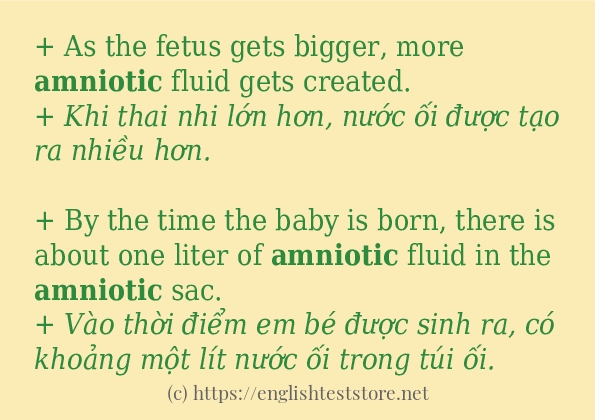Các cách sử dụng từ “amniotic”:
+ As the fetus gets bigger, more amniotic fluid gets created.
+ Khi thai nhi lớn hơn, nước ối được tạo ra nhiều hơn.
+ By the time the baby is born, there is about one liter of amniotic fluid in the amniotic sac.
+ Vào thời điểm em bé được sinh ra, có khoảng một lít nước ối trong túi ối.
+ The amniotic sac holds a fetus while it is developing during pregnancy.
+ Túi ối chứa thai nhi trong khi nó đang phát triển trong thai kỳ.
+ Artificial heart valves, working tracheas, as well as muscle, fat, bone, heart, neural and liver cells have all been engineered through use of amniotic stem cells.
+ Các van tim nhân tạo, khí quản làm việc, cũng như các tế bào cơ, mỡ, xương, tim, thần kinh và gan đều đã được thiết kế thông qua việc sử dụng các tế bào gốc từ nước ối.
+ The outside layer attaches to the umbilical cord, so that blood and oxygen from the mother can get through the amniotic sac and to the fetus.
+ Lớp bên ngoài gắn vào dây rốn, để máu và oxy từ mẹ có thể đi qua túi ối và đến thai nhi.
+ Once the baby is born, the amniotic sac is pushed out of the woman’s vagina in the afterbirth, along with the placenta.
+ Khi em bé được sinh ra, túi ối sẽ được đẩy ra khỏi âm đạo của người phụ nữ trong quá trình sinh nở, cùng với nhau thai.
+ Tissues got from amniotic cell lines show promise for patients suffering from congenital diseases/malformations of the heart, liver, lungs, kidneys, and cerebral tissue.
+ Các mô lấy từ các dòng tế bào ối cho thấy nhiều hứa hẹn đối với những bệnh nhân mắc các bệnh / dị tật bẩm sinh về tim, gan, phổi, thận và mô não.

Các câu ví dụ cách dùng từ “amniotic”:
+ A test called an amniocentesis can take a sample of amniotic fluid with a needle and study it for problems.
+ Một xét nghiệm được gọi là chọc dò nước ối có thể lấy một mẫu nước ối bằng kim và nghiên cứu nó để tìm ra các vấn đề.
+ Already, from the cells recovered by amniotic contuses, chromosome defects like triple-21 can be seen under the microscope.
+ Hiện tại, từ các tế bào được phục hồi do tắc nghẽn màng ối, các khuyết tật nhiễm sắc thể như bộ ba-21 có thể được nhìn thấy dưới kính hiển vi.
+ This fluid passes through the fetus’s digestive system and urinary system and gets urinated out into the amniotic fluid.
+ Chất lỏng này đi qua hệ tiêu hóa và hệ tiết niệu của thai nhi và được tiểu ra ngoài vào nước ối.
+ Some authors make a distinction between amniotic eggs and closed eggs of invertebrate groups such as insects and spiders.
+ Một số tác giả đưa ra sự phân biệt giữa trứng màng ối và trứng kín của các nhóm động vật không xương sống như côn trùng và nhện.
+ When a woman starts to childbirthgive birth, the amniotic sac should break and the amniotic fluid will leak out the woman’s vagina.
+ Khi người phụ nữ bắt đầu sinh con, túi ối sẽ vỡ ra và nước ối sẽ rò rỉ ra ngoài âm đạo của người phụ nữ.
+ Rarely, while giving birth, a woman can get a clot of amniotic fluid.
+ Hiếm khi trong khi sinh, người phụ nữ có thể bị tắc nước ối.
+ After the fetus is about four months old, when the kidneys start to work, the amniotic fluid serves another important purpose.
+ Sau khi thai nhi được khoảng bốn tháng tuổi, khi thận bắt đầu hoạt động, nước ối phục vụ một mục đích quan trọng khác.
+ A test called an amniocentesis can take a sample of amniotic fluid with a needle and study it for problems. + Một xét nghiệm được gọi là chọc dò nước ối có thể lấy một mẫu nước ối bằng kim và nghiên cứu nó để tìm ra các vấn đề.
+ A test called an amniocentesis can take a sample of amniotic fluid with a needle and study it for problems. + Một xét nghiệm được gọi là chọc dò nước ối có thể lấy một mẫu nước ối bằng kim và nghiên cứu nó để tìm ra các vấn đề.
+ The cleidoic egg is sometimes called the amniotic egg, because it is characteristic of amniotes.
+ Trứng cleidoic đôi khi được gọi là trứng đa ối, vì nó là đặc điểm của đa ối.
+ However, by the 12th to the 14th week of pregnancy, proteins, carbohydrates, lipids, phospholipids, and urea are all in the amniotic fluid.
+ Tuy nhiên, vào tuần thứ 12 đến tuần thứ 14 của thai kỳ, protein, carbohydrate, lipid, phospholipid và urê đều có trong nước ối.
+ The amniotic sac is filled with amniotic fluid, which protects the fetus.
+ Túi ối chứa đầy nước ối, có tác dụng bảo vệ thai nhi.
+ The amniotic sac has two layers, which have two different jobs.
+ Túi ối có hai lớp, có hai công việc khác nhau.
+ The fetus swallows amniotic fluid.
+ Thai nhi nuốt nước ối.
